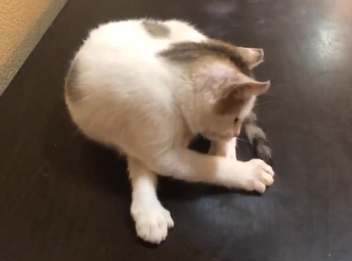
While many felines, like their canine counterparts, chase their tails as a form of amusement or pleasure, it’s a sight seen less often in cats than in dogs.
How many times have YOU witnessed your cherished pussycat companion circling round and round in an effort to capture her own tail?
According to animal experts, if a kitty is chasing her tail, it may not be for fun and frolics but rather as an exercise born out of sheer boredom. In that case, as a conscientious cat owner, redirect her attention towards chasing a piece of string, a favorite toy or the red beam of a laser pointer. And remember that high-value treats will both serve to reinforce your efforts and reward her compliance.
Concerned that your kitty is bored because you’re not home for extended periods of time? Keep her constructively occupied by leaving her with one or more interactive toys – from puzzle boards and rolling food dispenser toys to multilevel roller balls and rotating electric toys. These will help her focus more on playing with the toys and less on playing with her tail.
Sometimes, though, a cat will chase her tail (and even bite it at the same time) because of some underlying medical condition. She may have an infection that’s making her tail extremely uncomfortable. She may have an allergy that’s making it very itchy. She may have stud tail, a skin condition caused by overactive glands at the base of the tail. Or she may have Feline Hyperesthesia Syndrome, caused by overactive nerve endings that give her tail a tingly sensation.
Since you know your kitty’s body language best, if you suspect that her behavior is suspect, consult with your vet as soon as possible.
If yours is a multi-cat household, you may find yourself facing another situation: one cat playfully chasing or swatting at another cat’s tail. The solution? Separate them and redirect their attention to those oh-so-essential interactive toys.
A second, more worrisome scenario may involve one cat attacking, and sometimes biting, another cat’s tail. This may be either playful or pugnacious, depending on the attacker’s demeanor and the extent of the injuries – if any – sustained by the victim. Because a cat’s tail can become infected so easily and can be difficult to treat and resolve at home, any injury, however small, should automatically be examined by your vet.
If, however, all medical issues have been ruled out, and your feline friend continues to chase her tail in spite of your best efforts, locate a veterinary behaviorist in your area to evaluate her and assist you in finding the most paws-itive future course of action.









 RSS Feed
RSS Feed